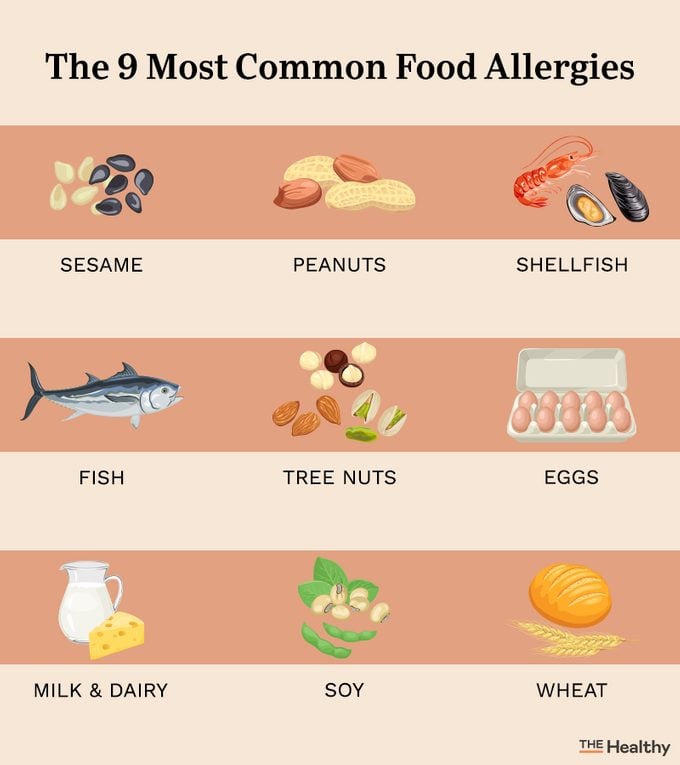These 9 Foods Are the Most Common Causes of Food Allergies
Updated: Jan. 19, 2023
Although you can be allergic to any food, these are the most common food allergies. Here's what allergists need you to know.
The most common food allergies
Most people know about food allergies to peanuts and shellfish. However, there are now nine foods that are considered responsible for almost all food allergies and must be listed on food labels.
A new one was just officially added to the list—sesame.
Although experts have long considered sesame a major food allergen, the seed was not required to be listed on food labels in the United States until the FASTER (Food Allergy Safety, Treatment, Education, and Research) Act was signed into law on April 23, 2021.
Over the next 20 months, companies will add warnings to their products, and the ingredient will be listed on all food labels by January 2023.
It’s a follow-up to the legislation originally from 2004 called the Food Allergen Labeling and Consumer Protection Act. It required manufacturers to label products that contained one of the eight other common food allergens. The law classified these eight as major food allergens.
What are major food allergens?
Julie McNarin, MD, an allergist-immunologist in Ithaca, New York, says that scientifically, a major allergen is considered to be any protein within the food that is likely to cause an allergic reaction among 90 percent of those who are allergic.
The more common definition, she says, is the group of foods that cause 90 percent of reactions and can cause severe anaphylactic reactions, which are relatively rare but potentially life-threatening.
Clearly, it’s crucial to indicate these ingredients on labels so people with allergies can stay safe and avoid allergic reactions. (Make sure you don’t fall for these dangerous myths about common food allergies.)
The 2004 law was essential in improving the safety of food consumption among those with the eight most common food allergies. Labeling was less stringent before, and companies could use alternate names of foods, leading to confusion among people with food allergies and their families, according to Dr. McNarin.
“This legislation will now make it much more straightforward to identify products that contain sesame,” she says. “Also, sesame may have previously been included as a ‘natural flavor,’ now it will be named in particular. ”
Without these laws, it’s tricky to know for sure whether packaged foods contain certain allergens like sesame.
What is a food allergy?
Food allergies develop when the body’s immune system becomes sensitized and overreacts to a particular food component.
That overactive immune response triggers the symptoms of the allergy, says allergist David Stukus, MD, the associate professor of Pediatrics in the Division of Allergy and Immunology, director of the Food Allergy Treatment Center at Nationwide Children’s Hospital, and member of the American College of Allergy, Asthma, and Immunology (ACAAI).
Eating even a small amount of the food may set off this response and lead to symptoms including hives, digestive issues, swollen airways, a sudden drop in blood pressure, pale skin, blue lips, fainting, dizziness, and in some cases, death, he says. Other more mild symptoms include an itchy or tingly mouth and runny nose.
“If you think you have a food allergy or even a food ‘sensitivity,’ it’s important to talk to an allergist about your symptoms and the best way to prevent and treat them,” Dr. Stukus says. “There are a lot of myths out there about food allergies, and these can be very harmful to people looking for answers about their symptoms.”
Here are the most common food allergies you need to know.

Sesame
Certain seeds, including sesame and mustard seeds (the main ingredient in the condiment mustard), also are common food allergy triggers. And as of April 23, 2021, sesame attained the status of major food allergen.
This news doesn’t surprise Dr. McNarin.
“I have been educating patients about top food allergens for many years, and have been including sesame in that list,” she sats. “The prevalence of sesame allergy is estimated to be as common as soy or pistachio (0.2 percent).”
It makes sense to add the seed to the list as research shows sesame allergies are more common than previously thought. One 2019 study in JAMA Network Open found that a sesame allergy affects one million children and adults in the United States.
Another 2019 JAMA Network Open study found that current epinephrine prescription (EpiPen) rates are the highest among adults with sesame allergy. Epinephrine and EpiPens are emergency treatments for serious allergic reactions.
Also troubling: Although less than 10 percent of adults with food allergies reported a food allergy-related emergency room visit within the past year, that rate jumped to 32 percent among sesame-allergic adults, according to the same report.
What can people sensitive to sesame do to protect themselves between now and 2023? Look for sesame and its aliases on ingredient lists. It may appear under many different names, including sesamol, benne seed, and sim sim.
In addition, sesame is commonly found in tahini, tempeh, vegetable oil, dips, spreads, processed meats, and seasonings, so it’s important to read labels closely. People who are allergic to sesame may also react to poppy, carroway, sunflower, or flaxseeds so keep an eye out for those as well.
“Sesame can be used in unexpected ways, one particular brand of lubricating eye drops, for example, contains sesame oil, and patients must remain vigilant, but with this change, it should make it slightly easier,” Dr. McNarin says.
Peanuts
Peanuts are the leading cause of severe allergic reactions to food, affecting nearly 2.5 percent of American children, making it one of the most common food allergies.
But there’s good news: While it was previously believed that an allergy to peanuts was lifelong, research has shown up to 20 percent of individuals with a peanut allergy eventually outgrow it, Dr. Stukus says.
Shellfish
Shellfish allergies are one of the most common adult food allergies that typically first appear in adulthood, according to the ACAAI. Within the shellfish family, the crustacean group (shrimp, lobster, and crab) causes the greatest number of allergic reactions.
Many people who are allergic to shellfish can still eat mollusks (scallops, oysters, clams, and mussels) with no problem, Dr. Stukus says.
However, all types of seafood are often prepared and served together. So if you’re highly reactive, avoid all of it unless you know its exact preparation.
Fish
Even though they both fall into the category of seafood, fish and shellfish are not the same. An allergy to fish is specifically an allergy to finned fish such as tuna, halibut, or salmon.
People who are allergic to fish may or may not be allergic to shellfish and vice versa. Again, it’s important to be careful of cross-contact or contamination. Talk to your allergist who may recommend or help you determine what is safe to eat.
Tree nuts
Tree nuts include almonds, Brazil nuts, cashews, hazelnuts, pine nuts, and walnuts, among others, and are a common cause of life-threatening allergies.
Peanuts are legumes, not nuts, but people with peanut allergies shouldn’t let their guard down.
About 25 to 40 percent of individuals who are allergic to peanuts will also react to at least one tree nut, Dr. Stukus says.
Eggs
If you get a rash or stomach pain after eating an omelet, you may have an egg allergy.
Egg allergies develop when your body’s immune system becomes sensitized and overreacts to proteins in egg whites and/or yolks, Dr. Stukus explains.
“The body sees the egg protein as a foreign invader and sends out histamines to defend against it, which causes the allergic reaction,” he says.
Egg allergies are more common in children, and fortunately, about 70 percent of children will outgrow the condition by age 16, according to the ACAAI.
Milk and dairy
Thanks to the proteins in milk, such as lactoglobulin, lactalbumin, casein, and whey, milk, and dairy from cows are common allergens.
Milk allergies almost always begin in the first year of life, affecting up to 7 percent of infants. About 80 percent of allergic children will outgrow milk allergies by age 16, according to the ACAAI.
People with an allergy to cow’s milk may also be allergic to milk from other animals, including sheep and goats, so be careful when trying dairy alternatives, Dr. Stukus cautions.
(Here are the foods you think are dairy-free that aren’t.)
Soy
Soy is one of the most common protein sources in the world, not just as tofu and edamame but as an ingredient in products such as granola bars, protein shakes, and infant formula.
Because soy can hide in some pretty sneaky places, it’s important to read labels carefully if you have a soy allergy, Dr. Stukus says.
Wheat
Don’t confuse a wheat allergy with gluten sensitivity or gluten intolerance.
Gluten includes proteins found in wheat, barley, and rye that can trigger serious symptoms in people with celiac disease, an autoimmune condition.
Other people can have a gluten intolerance and experience gastrointestinal or other health problems when they eat gluten, but don’t have the same intestine-damaging autoimmune reaction seen in people with celiac disease.
A wheat allergy, on the other hand, only occurs after exposure to wheat, and symptoms are typically mild, according to the ACAAI.
“People allergic to wheat should avoid obvious sources like bread, pasta, and cereals, but they also need to be cautious of non-food items that may contain wheat, such as Play-Doh, cosmetics, or bath products,” Dr. Stukus says.
And a wild card: Fruit
Although fruit is not on the list of major allergens, people can have allergic reactions to eating raw fruit such as apples, pineapples, and mangos. This is known as oral allergy syndrome or pollen-food allergy syndrome.
In this case, your body is actually allergic to pollen but cross-reacting to similar allergens found in raw fruit, vegetables, or some tree nuts, according to the ACAAI.
Take heart though: Even if raw fruits and veggies make you react, you can usually eat the same foods cooked, Dr. Stukus says. This is because the heating process distorts allergy-causing proteins, making them unrecognizable to your hyperactive immune system.
Now that you know about the most common food allergies, read about these common food myths that are wildly untrue.



